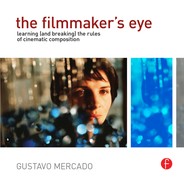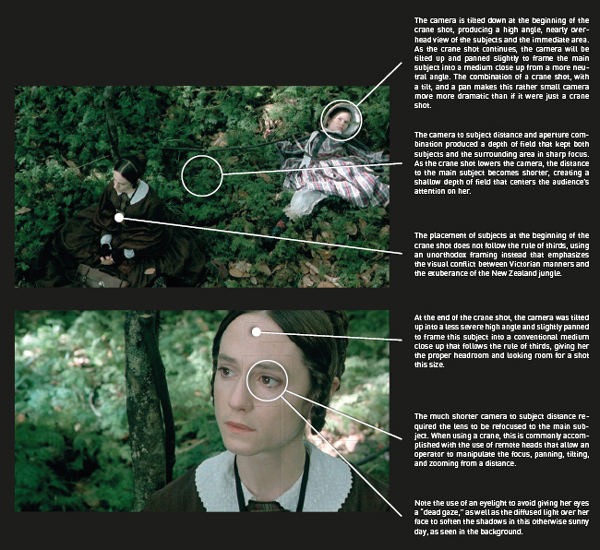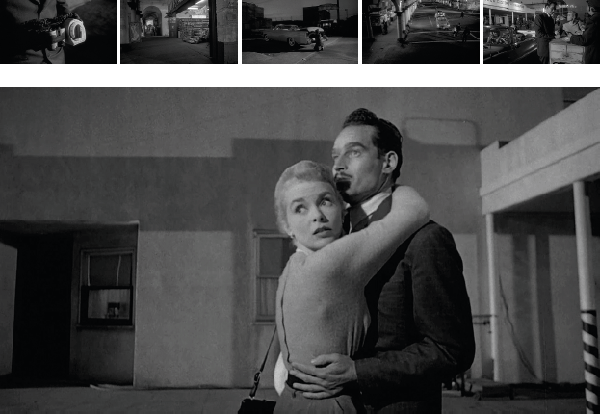crane shot
In a crane shot, the camera is mounted on a support that can be an actual crane, a jib arm, a cherry picker, or any other device that will allow the camera to be moved vertically, horizontally, or in a combination of both. The typical crane shot, however, emphasizes a vertical move of the camera that can encompass anywhere from just a few feet all the way up to more than one hundred feet in height. Although there are many variations, crane shots are most commonly used to gradually reveal the grand scale of a location or environment as the camera is moved upward, including more details as the camera’s vantage point gets higher. This type of crane shot can work essentially as an establishing shot, edited at the beginning of a scene or whenever a key location is introduced. The same crane move is also often used to gradually change the framing from a tight shot of a character to a wide shot of a location as the character recedes into the distance, usually at the end of a key scene or even the end of a film. Another extremely common crane shot essentially reverses this move, starting with a long or even an extreme long shot that includes a large area of a location that then moves downward into a tighter framing of a character, isolating her in the composition. The upward or downward movement of the camera in a crane shot can be made more apparent if there are objects in the foreground of the composition that pass by it as it is moved. These foreground elements might not be necessary if the crane shot elevates the camera significantly, since the change in vantage point will be very apparent in those cases; however, if the crane shot elevates the camera only a few feet and the subject is relatively distant from it, the move might go completely unnoticed unless something passes by the camera in the foreground of the composition. Crane shots can also be combined with other types of camera movement, by incorporating the use of dollies or other types of moving platforms that can add a great level of complexity to a shot (most notably in sequence shots). The use of a crane shot to introduce a location, a character, or to underline a key event, will make a powerful narrative statement that can convey there is something especially meaningful or relevant taking place, since the shift in the composition is accompanied by a shift in our understanding of the narrative meaning of the shot; its use should therefore be reserved only for those moments in your story where you want that shift in the minds of the audience to take place.
A classic use of a crane shot occurs in Ang Lee’s Crouching Tiger, Hidden Dragon (2000), during an extended flashback sequence where Jiao Long Yu (Zhang Zi-Yi), a member of an aristocratic family with a secret passion for martial arts, meets Lo “Dark Cloud” (Cheng Chang), the leader of a gang of desert bandits who ends up falling for her. Lo is introduced with a crane shot that gradually reveals him and his gang, combined with a tilting move of the camera that dramatically changes the vantage point from a low angle to a high angle. The visual emphasis conveyed by the use of a crane shot to introduce this character clearly suggests his importance in the story, and the fact that this territory is his domain. This use is a common technique designed to make a vivid first impression in the minds of the audience.
Ang Lee’s Crouching Tiger, Hidden Dragon (2000) uses a crane shot to dramatically reveal a gang of desert bandits and their leader, Lo (Cheng Chang).
crane shot
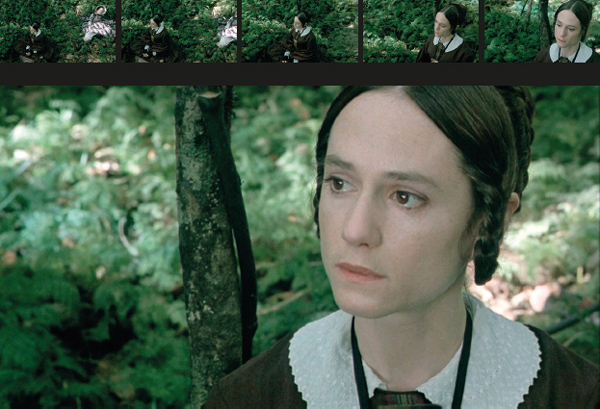
why it works
In addition to introducing narratively important locations or characters, crane shots can, like other dynamic camera moves, also underline especially poignant moments. In Jane Campion’s The Piano (1993), a crane shot is used when Ada (Holly Hunter), a mute Scottish woman who moves to New Zealand as part of an arranged marriage, decides to obey her husband and give piano lessons to the man who has her beloved piano so she can get it back. The dramatic emphasis conveyed by a descending crane shot externalizes the emotional turmoil caused by her decision to act against her will.
technical considerations
lenses
Your choice of focal length will of course depend on the type of crane shot, the blocking of the subjects within the composition, and the narrative point you are trying to make. For instance, a crane shot that gradually expands the frame as it elevates the camera to include a large area of a location (a common use of a crane shot to end a scene) would benefit from the use of a wide angle lens, since its wide field of view would let you include more of the location than if you used a telephoto lens. Conversely, a crane shot that emphasizes the upward movement of the camera by including elements in the foreground will appear to move faster when using a telephoto lens instead of a wide angle lens, because of the way they tend to distort movement along the x and y axes of the frame. Other variables that should influence your choice of focal length could include the amount of distortion you might want to add or exclude at some point in the crane shot. For instance, in the example from Campion’s The Piano on the previous page, the crane shot ends with a medium close up of a subject that would look significantly different if a wide angle or a telephoto lens had been used, since they would have distorted her features. Since crane shots can encompass a complex set of camera and subject movement, keep in mind that your choice of focal length can potentially work against the point of your shot if you ignore how it affects field of view and movement across all axes of the frame.
equipment
As with all dynamic camera moves, even the simplest crane shot will require extra time to set up, choreograph, and shoot; you should always account for this when planning your production schedule. There are over a hundred different models of cranes available for film and video production, anywhere from a jib arm that attaches to a tripod letting you elevate and lower the camera just a few feet, to large 8000 pound cranes that require at least two operators, and let you raise the camera over 100 feet. Other options include telescopic cranes, cranes with articulated arms, cranes that can suspend a Steadicam operator, motorized cranes that can cruise at highway speeds, and cranes that can support the weight of a large camera and two operators on a platform. One thing to keep in mind is that unless the crane can support an operator in addition to the camera, you will need some way to preview the frame as the crane shot is executed. This is accomplished with the use of a preview monitor attached at the end of the arm, letting the operator see the framing of the shot. However, this setup will not allow you to control focusing, zooming, panning, or tilting, unless the crane comes equipped with a motorized remote head to access these features. It is also extremely important to always remember that regardless of the crane type you are using, you must take extra safety precautions on the set (like never allowing anyone to walk under a crane, only letting qualified personnel operate it, never exceeding its weight and movement restrictions, making cast and crew aware of the movement that will be executed, and being aware of overhead power lines in the immediate area).
lighting
If the crane shot is taken outdoors during the day and a character is an integral part of the shot, lighting considerations will involve finding a way to diffuse the sunlight over her in a way that does not interfere with the rising or lowering movement of the camera, which might be difficult to do depending on the angle of incidence of the light. Crane shots taken on night exteriors can also present you with same problems you will encounter when taking long or extreme long shots under the same conditions; you will have to use powerful lights positioned at a high vantage point that can cover a wide area, or find a location with enough available light for this purpose.
breaking the rules
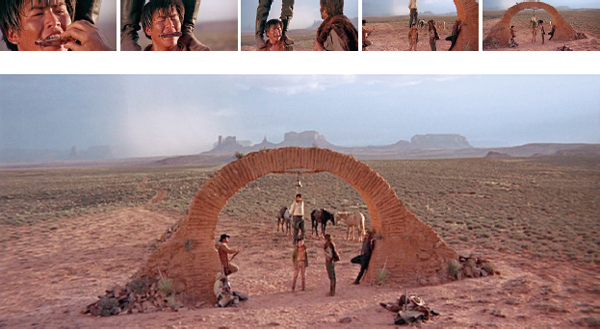
Crane shots are often combined with other camera moves (like pans and tilts) to augment the dramatic impact of a meaningful moment in a narrative. This example from Sergio Leone’s Once Upon a Time in the West (1968) adds even more complexity by also seamlessly incorporating a zoom out, a dolly out, and a tilt of the camera to a crane shot as it pulls back to reveal the sadistic killing of a man. Throughout the film, we followed “Harmonica” (Charles Bronson) as he relentlessly tracked down Frank (Henry Fonda), the leader of gang of ruthless killers, without knowing his motives. During their final showdown, Frank (and the audience) finally learns that years ago he had viciously killed Harmonica’s brother, during a flashback that uses a complex crane shot to convey the momentous significance of this event.
Touch of Evil. Orson Welles, 1958.
